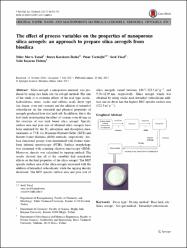| dc.contributor.author | Temel, Tülay Merve | |
| dc.contributor.author | İkizler, Burcu Karakuzu | |
| dc.contributor.author | Terzioğlu, Pınar | |
| dc.contributor.author | Yücel, Sevil | |
| dc.contributor.author | Elalmış, Yeliz Başaran | |
| dc.date.accessioned | 2020-11-20T14:51:52Z | |
| dc.date.available | 2020-11-20T14:51:52Z | |
| dc.date.issued | 2017 | |
| dc.identifier.issn | 0928-0707 | |
| dc.identifier.issn | 1573-4846 | |
| dc.identifier.uri | https://doi.org/10.1007/s10971-017-4469-x | |
| dc.identifier.uri | https://hdl.handle.net/20.500.12809/1820 | |
| dc.description | 0000-0003-4114-7044 | en_US |
| dc.description | WOS: 000411341300008 | en_US |
| dc.description.abstract | Silica aerogel, a nanoporous material, was produced by using rice husk ash via sol-gel method. The aim of the study is to examine effects of the acid type (acetic, hydrochloric, nitric, oxalic and sulfuric acid), dryer type (air, freeze, oven and vacuum) and the addition of tetraethyl orthosilicate on the structural and physical properties of aerogels produced from rice husk ash. In addition, this is the first study investigating the effect of vacuum oven drying on the structure of rice husk based silica aerogel. Specific surface area and pore size of obtained silica aerogels have been analyzed by the N-2 adsorption and desorption measurements at 77 K via Brunauer-Emmett-Teller (BET) and Barrett-Joiner-Halenda (BJH) methods, respectively. Surface functional groups were determined with fourier transform infrared spectroscopy (FTIR). Surface morphology was examined with scanning electron microscopy (SEM). Moreover, density was calculated by tapping method. The results showed that all of the variables had remarkable effects on the final properties of the silica aerogel. The BET specific surface area of the silica aerogels increased with the addition of tetraethyl orthosilicate, while the tapping density decreased. The BET specific surface area and pore size of silica aerogels varied between 140.7-322.5 m(2) g(-1), and 5.38-12.05 nm, respectively. Silica aerogel which was obtained by using oxalic acid, tetraethyl orthosilicate addition and air dryer had the highest BET specific surface area (322.5 m(2) g(-1)). | en_US |
| dc.description.sponsorship | Yildiz Technical University Projects Office [2015-07-04-KAP-05] | en_US |
| dc.description.sponsorship | This research is supported by Yildiz Technical University Projects Office (Project No: 2015-07-04-KAP-05). | en_US |
| dc.item-language.iso | eng | en_US |
| dc.publisher | Springer | en_US |
| dc.item-rights | info:eu-repo/semantics/openAccess | en_US |
| dc.subject | Dryer Type | en_US |
| dc.subject | Drying Method | en_US |
| dc.subject | Rice Husk Ash | en_US |
| dc.subject | Silica Aerogel | en_US |
| dc.subject | Sol-Gel Method | en_US |
| dc.subject | Tetraethyl Orthosilicate | en_US |
| dc.title | The effect of process variables on the properties of nanoporous silica aerogels: an approach to prepare silica aerogels from biosilica | en_US |
| dc.item-type | article | en_US |
| dc.contributor.department | MÜ, Fen Fakültesi, Kimya Bölümü | en_US |
| dc.contributor.institutionauthor | Terzioğlu, Pınar | |
| dc.identifier.doi | 10.1007/s10971-017-4469-x | |
| dc.identifier.volume | 84 | en_US |
| dc.identifier.issue | 1 | en_US |
| dc.identifier.startpage | 51 | en_US |
| dc.identifier.endpage | 59 | en_US |
| dc.relation.journal | Journal of Sol-Gel Science and Technology | en_US |
| dc.relation.publicationcategory | Makale - Uluslararası Hakemli Dergi - Kurum Öğretim Elemanı | en_US |


















